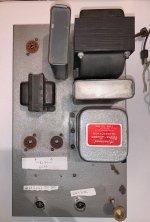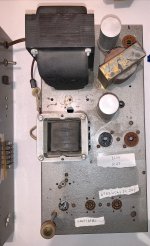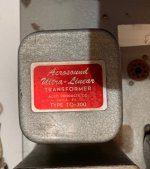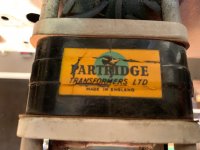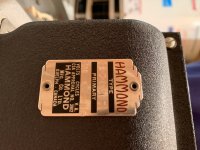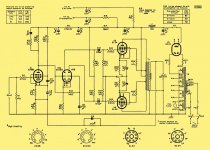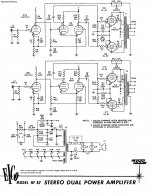Hello All,
Long time member of DiyAudio.com but a first time poster in the Tube/Valve Thread. I was gifted these mono block amplifiers years ago from an elderly gentleman that appreciated and shared my love for music and audio gear. I was told they are 15 watt, Class A push-pull. Based on Google searches they seem to be similar to Heathkit or Zenith kits, all point to point wiring, possibly from the 60’s. Although the chassis sizes are slightly different they both use the same EL34/6CA7 power tubes, rectifier and input/preamp tubes (although they do have different brand output transformers) so I’m assuming they’re just different versions or editions of the same design. I have all of the tubes they came with and a compliment of extras (all used) as well.
I’ve had these for over 10 years and had hoped to refurbish them and get them up and running but haven’t had the time, or any experience with tube gear. I have however built kits from the DIYAudio Store. Can someone tell me what they might be, and what they’re possibly worth? I’d like to sell them because I’m realizing I’ll never have time for them. From what I’ve gathered on line the Hammond Transformers (which are very heavy for their size) alone are “fairly” expensive on the used market.
Any help, advice and information would be greatly appreciated!
Long time member of DiyAudio.com but a first time poster in the Tube/Valve Thread. I was gifted these mono block amplifiers years ago from an elderly gentleman that appreciated and shared my love for music and audio gear. I was told they are 15 watt, Class A push-pull. Based on Google searches they seem to be similar to Heathkit or Zenith kits, all point to point wiring, possibly from the 60’s. Although the chassis sizes are slightly different they both use the same EL34/6CA7 power tubes, rectifier and input/preamp tubes (although they do have different brand output transformers) so I’m assuming they’re just different versions or editions of the same design. I have all of the tubes they came with and a compliment of extras (all used) as well.
I’ve had these for over 10 years and had hoped to refurbish them and get them up and running but haven’t had the time, or any experience with tube gear. I have however built kits from the DIYAudio Store. Can someone tell me what they might be, and what they’re possibly worth? I’d like to sell them because I’m realizing I’ll never have time for them. From what I’ve gathered on line the Hammond Transformers (which are very heavy for their size) alone are “fairly” expensive on the used market.
Any help, advice and information would be greatly appreciated!
Attachments
Last edited:
These are a DIY effort based on the Mullard 5-20 circuit.
You could sell the Acro and Partridge OTs off the chassis and replace them with something that matches and pocket a little money. IIRC, the Partridge OT is what was specified in the original 5-20 design.
You could sell the Acro and Partridge OTs off the chassis and replace them with something that matches and pocket a little money. IIRC, the Partridge OT is what was specified in the original 5-20 design.
I would not attempt to restore them, a buyer would just want the transformers anyway.
Ebay them as-is for parts only.
Ebay them as-is for parts only.
Hi Rayma, thanks for your reply. Are you referring to the Hammond transformers or the audio transformers? And, what would be a reasonable asking price. I could obviously just see what the going asking price is but I’d like to know what a knowledgeable diy enthusiast thinks.
Thanks 🙂
Thanks 🙂
These are a DIY effort based on the Mullard 5-20 circuit.
You could sell the Acro and Partridge OTs off the chassis and replace them with something that matches and pocket a little money. IIRC, the Partridge OT is what was specified in the original 5-20 design.
Thanks for the information!
If it was me, I'd definitely try firing them up - hope you have a variac on hand!
1. You could test the tubes this way.
2. You could say "verified operational" on the output transformers, power transformers, choke, oil filled B+ caps...
I'm sure many tube people out there would love to have these parts. They would feel a lot better about spending some real money for them if they knew they were "tested good". It wouldnt be all that much of an effort to do - provided at least one of the amps comes up and operates pretty much correctly.
For example, voltage on the 6CA7 plate, drop across the cathode bias resistor, value of that resistor, zero red plate glow - would go a lot farther for someone than "6CA7 tubes - untested, sold in as-is condition".
So many ebay sellers are so freakin' lazy - you read a description and all it says is "Ships with USPS priority mail". Yeah, thanks - I might as well start a fire with $20 bills...
1. You could test the tubes this way.
2. You could say "verified operational" on the output transformers, power transformers, choke, oil filled B+ caps...
I'm sure many tube people out there would love to have these parts. They would feel a lot better about spending some real money for them if they knew they were "tested good". It wouldnt be all that much of an effort to do - provided at least one of the amps comes up and operates pretty much correctly.
For example, voltage on the 6CA7 plate, drop across the cathode bias resistor, value of that resistor, zero red plate glow - would go a lot farther for someone than "6CA7 tubes - untested, sold in as-is condition".
So many ebay sellers are so freakin' lazy - you read a description and all it says is "Ships with USPS priority mail". Yeah, thanks - I might as well start a fire with $20 bills...
Hi jjasniew,
Thanks for your reply. Unfortunately I don't have a variac, I've only used a bulb tester as a voltage limiter when initially firing up my SS projects so I'm not really confident firing the units up as I've never worked on tube amplifiers and the voltages they can produce. I'm not eager to have something "blow up" on me. The unit's apparently worked when they were given to me, but I didn't see them operational or fire them up at the time.
Thanks for your reply. Unfortunately I don't have a variac, I've only used a bulb tester as a voltage limiter when initially firing up my SS projects so I'm not really confident firing the units up as I've never worked on tube amplifiers and the voltages they can produce. I'm not eager to have something "blow up" on me. The unit's apparently worked when they were given to me, but I didn't see them operational or fire them up at the time.
The amp built with the Acrosound O/P trafo appears to use oil caps., in its PSU. Those things, unless they spring a physical leak, never go bad. OTOH, electrolytic caps. literally dry out over time and should, as a matter of routine, be replaced.
The amp built with the Partridge O/P trafo employs "can" caps., which are 'lytic. Clamp mounting "snap in" or other modern parts in the existing chassis openings is a convenient way to replace those old, dried out, 'lytics.
The 'lytics in SS equipment suffer from the same drying problem.
I've provided the schematic for the previously mentioned Mullard 5-20. I am also providing the schematic for EICO's HF-87, which employs Mullard style circuitry. The Noval 6CG7/6FQ7 and the Octal 6SN7 are electrically equivalent. FWIW, I'm guessing the circuitry present is a hybrid of what's present in the 5-20 and HF-87, with an EF86 voltage amplifier and a 6CG7 long tailed pair (LTP) phase splitter.
To this day Hammond manufactures the 278X power trafo. 😉 Old magnetics that are electrically intact hold and (sometimes) appreciate in value. I agree with the suggestion that the Acrosound and Partridge "singles", which are quite valuable, be sold to fund the acquisition of a "matching" pair of O/P trafos. For the Canadian OP, Hammond's 1650NA seems to be correct.
BTW, which rectifier type(s) is used?
The amp built with the Partridge O/P trafo employs "can" caps., which are 'lytic. Clamp mounting "snap in" or other modern parts in the existing chassis openings is a convenient way to replace those old, dried out, 'lytics.
The 'lytics in SS equipment suffer from the same drying problem.
I've provided the schematic for the previously mentioned Mullard 5-20. I am also providing the schematic for EICO's HF-87, which employs Mullard style circuitry. The Noval 6CG7/6FQ7 and the Octal 6SN7 are electrically equivalent. FWIW, I'm guessing the circuitry present is a hybrid of what's present in the 5-20 and HF-87, with an EF86 voltage amplifier and a 6CG7 long tailed pair (LTP) phase splitter.
To this day Hammond manufactures the 278X power trafo. 😉 Old magnetics that are electrically intact hold and (sometimes) appreciate in value. I agree with the suggestion that the Acrosound and Partridge "singles", which are quite valuable, be sold to fund the acquisition of a "matching" pair of O/P trafos. For the Canadian OP, Hammond's 1650NA seems to be correct.
BTW, which rectifier type(s) is used?
Attachments
BTW, which rectifier type(s) is used?
Hi Eli,
One of the Tubes has a metal base and Rogers printed on it with 6 letters and numbers stamped into it that I cant all make out, The last 3 characters are 55F.
The second amp has a 5U4GB tube.
The only Western metal base rectifier I know is the GZ34 (5AR4), but there could be more.
(19)55 sounds right for the Philips metal base octal era.
Better post a picture to help with the identification.
(19)55 sounds right for the Philips metal base octal era.
Better post a picture to help with the identification.
- Home
- Amplifiers
- Tubes / Valves
- Help Identifying Tube Amps
